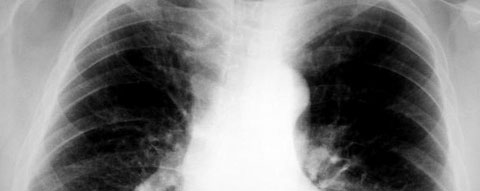Home > Press > Potential Health Impact of Inhaled NanoMetals to be Studied by Multidisciplinary Team at Johns Hopkins
 |
| X-ray of lungs. Credit: Clara Natoli / MorgueFile |
Abstract:
Every day, everywhere we go, whether we know it or not, we are exposed to nanomaterials—particles with one dimension no bigger than 1/100,000th the width of a human hair. They can be found in cosmetics, sunscreens, pharmaceuticals, fabrics, and in the air we breathe. It is a challenge to measure how often we encounter these ubiquitous bits of next-to-nothingness and what, if any, impact they may have on our health in an open environment. But three Johns Hopkins University researchers affiliated with the Institute for NanoBioTechnology hope to gain some insight on those effects by studying the ability of nanometals to access lung tissues, their potential to trigger pro-inflammatory reactions by cells that line the lung airways, and even the extent to which workers are exposed in a nanomaterials manufacturing setting.
Potential Health Impact of Inhaled NanoMetals to be Studied by Multidisciplinary Team at Johns Hopkins
Baltimore, MD | Posted on September 8th, 2008The National Science Foundation awarded nearly $400,000 to faculty members Shyam Biswal, Patrick Breysse, and Justin Hanes for their collaborative investigation on the toxic health effects of nanometal oxides. "Exposure to nanomaterials in occupational settings is measurable, while exposure in non-occupational settings is hard to characterize," says Biswal, a toxicologist at the Bloomberg School of Public Health and principal investigator on the project. "The knowledge we gain from these studies will help in understanding the health effects of nanoparticles that we might encounter in everyday situations."
Breysse directs the division of Environmental Health Engineering in the Department of Environmental Health Sciences in the Bloomberg School of Public Health. Hanes, professor of chemical and biomolecular engineering in the Whiting School of Engineering, is director of Therapeutics for INBT.
When used in consumer products, nanomaterials provide many benefits, and production of items that use nanomaterials is on the rise. The National Science Foundation estimates that 2 million workers will be needed to support nanotechnology industries worldwide within 15 years*. There is already a large body of research on how exposure to metals impacts both humans and animals, linking it to a range of inflammatory diseases such as asthma, cystic fibrosis and chronic obstructive pulmonary disease. However, little is understood about the toxic potential of metal oxides manufactured at the nanoscale.
Biswal, Breysse and Hanes plan to look at how workers become exposed to nanomaterials, how they are transported through the body, and then assess any potential adverse health effects. One goal of the project will characterize the basic physical and chemical properties of the engineered nanometal oxides. Another goal will be to determine what size, what type and how much nanometal oxides are found in the exhaled breath of exposed workers.
Biswal says the project is an excellent representation of a multidisciplinary collaboration between experts in exposure assessment, aerosol science, nanotechnology, the protective mucus barrier, and pulmonary molecular toxicology.
"The nanometal particle is not only important from an occupational point of view. We think that what we learn from these particles will help us understand the effect of other nanoparticles to which we all are exposed," Biswal adds. "These studies also will develop the knowledge base required for future studies on larger populations exposed to nanometal particles."
Other collaborators on this research include Biswal's research associate Rajesh Thimmulappa; Alexendra Stefanik, an industrial hygienist with the National Institute for Occupational Safety and Health who previously conducted research with Breysse; and Jana Keshavan of the U.S. Army's Edgewood Chemical Biological Center. This current project grew out of a previous study (Toxicological evaluation of nanoparticles in mice model of chronic lung diseases) funded with seed money from INBT.
Story by Mary Spiro
####
For more information, please click here
Copyright © Institute for NanoBioTechnology
If you have a comment, please Contact us.Issuers of news releases, not 7th Wave, Inc. or Nanotechnology Now, are solely responsible for the accuracy of the content.
| Related News Press |
News and information
![]() Researchers develop molecular qubits that communicate at telecom frequencies October 3rd, 2025
Researchers develop molecular qubits that communicate at telecom frequencies October 3rd, 2025
![]() Next-generation quantum communication October 3rd, 2025
Next-generation quantum communication October 3rd, 2025
![]() "Nanoreactor" cage uses visible light for catalytic and ultra-selective cross-cycloadditions October 3rd, 2025
"Nanoreactor" cage uses visible light for catalytic and ultra-selective cross-cycloadditions October 3rd, 2025
Announcements
![]() Rice membrane extracts lithium from brines with greater speed, less waste October 3rd, 2025
Rice membrane extracts lithium from brines with greater speed, less waste October 3rd, 2025
![]() Researchers develop molecular qubits that communicate at telecom frequencies October 3rd, 2025
Researchers develop molecular qubits that communicate at telecom frequencies October 3rd, 2025
![]() Next-generation quantum communication October 3rd, 2025
Next-generation quantum communication October 3rd, 2025
![]() "Nanoreactor" cage uses visible light for catalytic and ultra-selective cross-cycloadditions October 3rd, 2025
"Nanoreactor" cage uses visible light for catalytic and ultra-selective cross-cycloadditions October 3rd, 2025
Safety-Nanoparticles/Risk management
![]() Onion-like nanoparticles found in aircraft exhaust May 14th, 2025
Onion-like nanoparticles found in aircraft exhaust May 14th, 2025
![]() Closing the gaps — MXene-coating filters can enhance performance and reusability February 28th, 2025
Closing the gaps — MXene-coating filters can enhance performance and reusability February 28th, 2025
|
|
||
|
|
||
| The latest news from around the world, FREE | ||
|
|
||
|
|
||
| Premium Products | ||
|
|
||
|
Only the news you want to read!
Learn More |
||
|
|
||
|
Full-service, expert consulting
Learn More |
||
|
|
||








